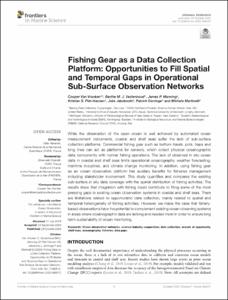Fishing Gear as a Data Collection Platform: Opportunities to Fill Spatial and Temporal Gaps in Operational Sub-Surface Observation Networks.

View/
Average rating
votes
Date
2020Author
Van Vranken, C.
Vastenhoud, B.M.J.
Manning, J.P.
Plet-Hansen, K.S.
Jakoboski, J.
Gorringe, P.
Martinelli, M.
Metadata
Show full item recordAbstract
While the observation of the open ocean is well achieved by automated ocean
measurement instruments, coastal and shelf seas suffer the lack of sub-surface
collection platforms. Commercial fishing gear such as bottom trawls, pots, traps and
long lines can act as platforms for sensors, which collect physical oceanographic
data concurrently with normal fishing operations. The lack of observed in situ ocean
data in coastal and shelf seas limits operational oceanography, weather forecasting,
maritime industries, and climate change monitoring. In addition, using fishing gear
as an ocean observation platform has auxiliary benefits for fisheries management
including stakeholder involvement. This study quantifies and compares the existing
sub-surface in situ data coverage with the spatial distribution of fishing activities. The
results show that integration with fishing could contribute to filling some of the most
pressing gaps in existing ocean observation systems in coastal and she.....
Journal
Frontiers in Marine ScienceVolume
7Issue
Artice 485512Page Range
19pp.Document Language
enSustainable Development Goals (SDG)
14.aEssential Ocean Variables (EOV)
N/ADOI Original
10.3389/fmars.2020.485512Citation
Van Vranken, C., Vastenhoud, B.M.J., Manning, J.P., Plet-Hansen, K.S., Jakoboski, J., Gorringe, P. and Martinelli, M. (2020) Fishing Gear as a Data Collection Platform: Opportunities to Fill Spatial and Temporal Gaps in Operational Sub-Surface Observation Networks. Frontiers in Marine Science, 7:485512, 19pp. DOI: 10.3389/fmars.2020.485512Collections
The following license files are associated with this item:
 Repository of community practices in Ocean Research, Applications and Data/Information Management
Repository of community practices in Ocean Research, Applications and Data/Information Management
